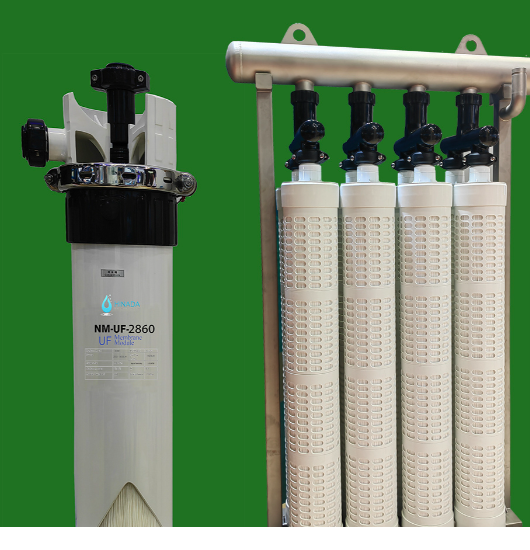PVDF ultrafiltration membranes revolutionize filtration by providing comprehensive advantages to water treatment facilities alongside biopharmaceutical plants, food and beverage companies and wastewater treatment centers. Upgraded polymer technology produces these membranes which demonstrate remarkable properties that make them the optimal selection for ultrafiltration operations. This section examines the industrial application that drive industry performance.
Features of PVDF ultrafiltration membranes
Exceptional Chemical and Thermal Stability
PVDF ultrafiltration membranes stand out for facing up well against numerous chemicals. The chemical resistance of PVDF extends to acids and bases organic solvents and oxidizing agents permitting unrestricted usage. The membranes’ robust construction enables them to preserve both functional integrity and operational performance under extremely harsh chemical conditions thus providing exceptional capability for industrial wastewater treatment and chemical processing needs.
PVDF membranes demonstrate exceptional thermal stability which enables them to operate at different temperatures within a wide operating range.
High Mechanical Strength and Durability
The outstanding durability of PVDF membranes has become a crucial quality that extends the functional capacity of ultrafiltration membrane systems. The strength properties run high in PVDF membranes which shields them from physical damage while in operation or cleaning processes or contact events. The membranes demonstrate mechanical resilience to maintain function during intense pressure applications and standard backwashing protocols widespread in water treatment methods.
PVDF membranes demonstrate extended service lives because of their durability which reduces replacement requirements and delivers cost savings. The durability characteristic of PVDF ultrafiltration membranes enables them to serve effectively at multiple scales from significant industrial facilities to smaller systems altogether.
Superior Fouling Resistance
During ultrafiltration processes, membranes endure surface fouling which emerges from the accumulation of particles of microorganisms and organic materials. Hydrophilic characteristics of PVDF ultrafiltration membranes therefore alleviate this drawback. Many such PVDF membranes are either surface-modified or blended to enhance hydrophilicity to minimize foulant adhesion.
This increased fouling resistance results in ongoing high flux as low-frequency cleanability reduces repeated cleansing cycles, which therefore ensures maximum efficiency while drastically reducing the cost of filtration in terms of operation. There are no end uses that appreciate superior antifouling better, from municipal drinking and wastewater recovery water to biomedical membrane uses that normally are adversely challenged by bio-accumulations under these situations.
Good Porous Quality with High Flux Ends
Characteristically, the porous ultrafiltration membrane made from PVDF is distinguished by high porosity and even pore size distribution. Such an attribute of this product ensures superior performance in filtration capabilities, making effective removal of particles such as suspended solids, bacteria, viruses, and colloidal matters dissolved in liquids from liquids.
This porosity combined with proven filtration functionality made PVDF membrane indispensable for such stringent applications like, for instance,e ultrapure water intended for use within semiconductor fabrication process or pharmaceuticals in sterile filtration, among many more.
Ease of cleaning and maintenance
Another interesting characteristic of PVDF ultrafiltration membranes is their ease of cleaning. They are tolerant of aggressive cleaning agents and procedures, such as chemical cleaning with alkaline and acidic solutions. This allows fouling and scaling to be removed from the membrane, thereby returning its performance to its original level.
Additionally, the PVDF membranes are compatible with harsh cleaning regimes; hence their operational lifetime may be extended. This makes them an affordable and sustainable means for long-term use. Industries whose procedures include frequent cleaning, such as dairy processing and beverage production, are most favored in this regard.
Versatility Across Applications
PVDF ultrafiltration membranes show great adaptability across numerous application areas. It can be used in nearly any application with water treatment: PVDF ultrafiltration membranes serve multiple applications including the treatment of drinking water while also recycling wastewater and preparing desalination input. PVDF ultrafiltration membranes within the food and beverage sector maintain product quality by eradicating unwanted impurities together with microorganisms. PVDF membranes serve hospitals and pharmaceutical firms by making sterile filters that ensure clean medical products while maintaining their effectiveness.
Due to their adaptable nature, the membrane configurations including flat sheets and hollow fiber along with spiral wound modules can fulfill diverse industrial demands.
Resistance to UV and Oxidative Damage
Hinada’s PVDF membranes demonstrate outstanding performance against ultraviolet (UV) radiation by showing resistance alongside protection against oxidative agents such as chlorine and ozone. Membranes need this durability when they come into contact with disinfectants as well as direct exposure to sunlight. The disinfection treatment procedures of municipal water treatment systems regularly use chlorine which PVDF membranes successfully resist without altering their filtration capabilities throughout extended exposure periods.
Oxidative resistance of PVDF ultrafiltration membranes acts to prolong membrane lifecycle which reduces replacement costs and overall operational expenses. The feature provides a superior advantage to filtration systems operating outdoors or remotely since they lack ample maintenance resources.
Summary
Hinada’s PVDF ultrafiltration membranes unite sophisticated polymer development methods with real-world operational skills to establish unprecedented advantages throughout diverse industries. PVDF membranes distinguish themselves because of their heat stability combined with chemical stability. While maintaining excellent mechanical properties alongside their superior anti-fouling characteristics and filtration capabilities. This membranes offer a formidable filter solution to contemporary challenges through their convenient maintenance. Practices alongside their adaptive capabilities and ecologically friendly operations.
PVDF ultrafiltration membranes will thrive in future industrial demands through their dependable generation of affordable filtration solutions that maintain environmental sustainability.
FAQs
PVDF ultrafiltration membranes stand apart from other filtration membranes because of what characteristics?
These exceptional properties of chemical resistance thermal stability and anti-fouling protection enable PVDF membranes to persist in various filtration applications effectively.
Does PVDF membrane technology maintain its performance at elevated temperature ranges?
PVDF membranes function effectively even at high temperatures which enables their applications for sterilization together with industrial processes.
What properties make PVDF membranes effective at blocking fouling?
The membrane’s hydrophilic nature reduces surface contamination which helps prevent performance degradation.
What are the conditions under which PVDF membranes prove suitable for chemical filtering applications?
PVDF membranes prove suitable for harsh chemical environments due to their complete resistance against acid bases and organic solvents.




